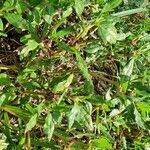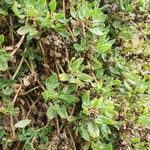A herb that keeps growing from year to year. It lies along the ground. The leaves are 2-4 cm long and 1-2 cm wide. The flowers are in the axils of leaves. They can occur singly or in groups of 2-5. They do not have flower stalks. The fruit is a capsule with a lid. It is 2-5 mm long. There are 4 seeds. The seeds are black and 1.5 mm long.
Leaves opposite, usually unequal; leaf-lamina 8–45 × 2–20 mm., oblanceolate, narrowly to broadly elliptic, obtuse to rounded at the apex, glabrous or pubescent below or on the midrib only, slightly succulent; petiole up to 20 mm. long, membranous-winged and sheathing at base, usually pubescent.
Prostrate herb. Leaves opposite, blades elliptical or oblong, 15-30 mm long, apex obtuse, petioles 4-8 mm long with narrow entire sheath at base. Flowers axillary in groups. Flowers pink or greenish red.
Perianth lobes 3–5 mm. long, the segments united for c. 1/2 their length, subacute, shortly mucronate, with narrow membranous edges.
Fruit c. as long as the perianth, splitting c. 1/3 from the base along a smooth thickened rim; valves of the operculum separating.
A many-stemmed spreading prostrate or procumbent slightly succulent herb, rather coarse and sometimes ± woody at base.
Branches up to 60 cm. long, covered with short rough hairs when young, later glabrescent.
Flowers in crowded groups of 5–20, sessile or subsessile, pale green to purple.
Ovary truncate, with a shallow apical depression.
Seeds 4, subspherical-reniform, sulcate.
Stamens 5.








